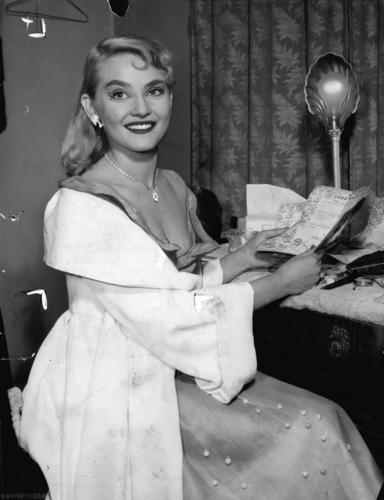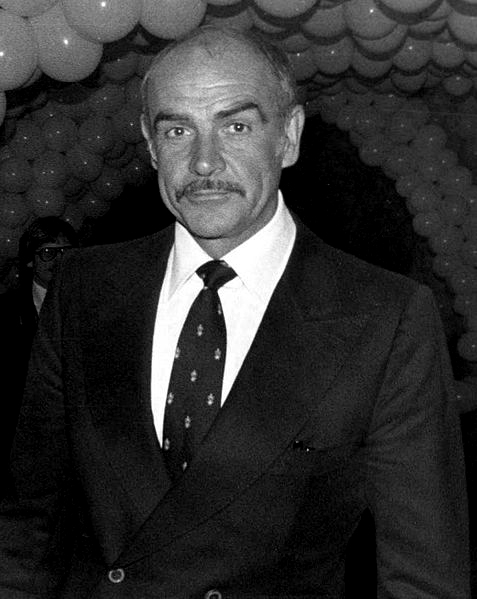Sir Thomas Sean Connery: James Bond in Kilburn and West Hampstead
Before London
On his dad’s side, Sean, or as his birth certificate records ‘Thomas’ Connery, had Irish roots. His dad was Joe, a jobbing labourer in Edinburgh who married Effie Maclean in 1928. Thomas (Tommy) was born two years later in Fountainbridge, Edinburgh’s industrial district, where the grime and smoke had gained it the nickname, Auld Reekie. There wasn’t much money and Tommy had a tough childhood. He got his first job when he was nine years old; helping on a milk round before school, with an evening shift as well at a butcher’s. He was a physically strong kid, fit and good at sport, but he was restless, and keen to leave Fountainbridge behind. So he joined the navy when he was seventeen. Although he signed up for seven year’s active service he was invalided out in 1949, suffering from duodenal ulcers.
Back in Edinburgh, Connery took up a British Legion scholarship and trained as a French polisher. He was a seriously good footballer and at one point might have decided on a professional career but he was also devoting hours to body building. In 1952, he worked as a life guard at the Portobello Pool and he earned more money posing as an (almost) nude model at Edinburgh College of Art. His well-toned physique and dark good looks made him very popular: ‘The girls always wanted to sketch me up close, it was embarrassing.’ He also posed for photos in musclemen magazines. His coach (another body builder), suggested they go to London where his biographer Michael Callan, says Connery entered the 1953 ‘Mr Universe’ competition, coming third. Records are patchy which probably explains why other sources disagree, for example, saying he went to London on his own; that he entered the junior man section; that he failed to place in the ‘tall man’ section; or even that he entered the Scottish and not the London heats. Several contemporary photos of him reveal an impressive physique.
With money running low, Connery was about to return to Scotland when he auditioned and got a job in the chorus of a travelling show of South Pacific. It paid £12 a week, about £260 today. Connery knew and liked the theatrical world; he’d worked briefly behind the scenes in an Edinburgh theatre with a walk-on role in a play, but his acting career truly began in London, in 1953.
London
Around this time, ‘Tommy’ or ‘Tammy’ as he was sometimes known, became ‘Sean.’ Always a grafter, he worked hard but found himself out of work when the two year run of South Pacific ended. A few stage parts were followed by his first TV role (1956) and a film No Road Back (1957), where he played Spike, a minor gangster. There’s a good if unsubstantiated anecdote at: http://en.wikipedia.org/wiki/No_Road_Back.
To make some extra money Connery worked as a baby sitter at 46 Abbey Road, the home of Peter Noble, a journalist and film buff. Sean charged 10 shillings an evening and another 10 shillings for every dirty nappy he had to change; (as Peter recalled, sometimes there were at least two). Noble got to know Sean through his friends Llew and Merry Gardner, who had a first floor flat at 67 Brondesbury Villas, where Sean lodged for a year, paying 12sh 6d a week. Llew was a TV presenter who later worked on World In Action. Merry worked with Sean’s current girlfriend, photographer and actress Julie Hamilton.
Llew said;
My first impressions were of a very large, very hirsute Scottish young man who kept working out with dumbbells. He had a collection of pictures showing himself in body beautiful poses for which he must have shaved all over because there wasn’t a trace of hair to be seen. What struck me most about him was he was very canny, not easily impressed by those in a position to offer him money and fame.
Llew remembered that Sean used to bargain with the Kilburn traders over clothes and food: ‘he could go out and buy the cheapest piece of meat and turn out a very good stew.’ When he bought a second-hand, three legged bed, the Gardners gave him thirteen volumes of the works of Stalin to use as the fourth. ‘I imagine it was the first time that Stalin had ever been screwed that way.’
Connery was living with the Gardners when Requiem for a Heavyweight went out on the BBC on 31 March 1957. It told the story of an ageing boxer at the end of his career. In Fountainbridge his parents watched their son on a new TV Set; ‘By Heavens, that was smashing,’ said Joe. Sean went home to Kilburn after his performance, celebrating with a typical meal of stew and a glass of beer.
The reviews were generally good, the Times praising his ‘shambling and inarticulate charm.’ Unfortunately any recording of this broadcast has been lost.
Connery was signed by 20th Century Fox but waited in Kilburn for work to materialise. He landed the role of Mike in Action of the Tiger(MGM, 1957), but the director Terence Young believed the film would flop and told a disappointed Sean: ‘Just keep at it and I’ll make it up to you.’ Four years later Young kept his word when he was sent the film script of Dr No.
In 1958 Sean moved a short distance across the Kilburn High Road to the quiet 3 Wavel Mews, off Acol Road. His new home – which he bought – comprised three rooms above a garage. Julie Hamilton, who was the daughter of film director Jill Craigie and the step-daughter of politician Michael Foot, moved in with him. Jill Craigie helped with the purchase of the property. Local directories show ‘T. Connery’ at Number 3. He started renovations around the time he began work on Another Time, Another Place (Paramount, 1958). He also returned to serious body building: his close friend and fellow actor Ian Bannen, often stayed at Wavel Mews: ‘he had all the equipment and he was deadly earnest about it, sometimes it was like a gym.’ Sean had always favoured a motorbike for personal transport and he still did. Bannen again: ‘it remains in my memory only because he was always falling off. Didn’t seem he could go down a bloody road without hitting some tree or something.’ Bannen moved into Number 3 when Connery was offered a major part in Disney’s Darby O’Gill and the Little People(1959), which was filmed in America. The ‘little people’ of the title were leprechauns and it was Connery’s first big hit.
Bannen left Wavel Mews when Sean returned from Hollywood and started converting the garage space below the flat into a sitting room. More stage and TV work as well as several films followed: Tarzan’s Greatest Adventure (Paramount 1959), The Frightened City (1961), On the Fiddle (1961) and a small part in The Longest Day (1962). But for Connery, ‘the storms of uncertainty were about to abate, to be replaced by a tempest of frenetic adulation and unstoppable fame.’ Albert Broccoli and Harry Saltzmann offered Terence Young (not their first choice), the chance to direct Dr No.
‘I’m looking for Commander James Bond, not an overgrown stunt man.’
Ian Fleming’s reported response on first meeting Sean Connery
Sean was in the running for the role of 007, but so were many other actors with far stronger pedigrees: Cary Grant; David Niven; Patrick McGoohan (Danger Man and The Prisoner); Roger Moore (who went on to become Bond in Live and Let Die), plus established British stars Richard Johnson, Rex Harrison, Michael Redgrave and Trevor Howard. Tipping the scales in Connery’s favour was possibly the fact Broccoli’s wife had seen Sean in Darby O’Gill and told her husband his ‘macho aura was inescapably attractive’: in other words, he had sex appeal. When Connery started testing, United Artists cabled Broccoli and Saltzmann, ‘see if you can do better’ but they were already committed to the Scotsman. Sean signed a multi-picture deal that held until 1967, and his casting as James Bond was announced on 3 November 1961. Quoted figures for the fee Sean received for Dr No range from £3,000 to as high as £25,000, (equivalent to £50,000 to £420,000 today).
Connery was ‘groomed’ extensively to fit the part. A top notch London tailor Anthony Sinclair was hired who described Sean as having perfect figure on which to hang clothes. When asked how he would manage to conceal Bond’s shoulder holster under his armpit without ruining the line of the suit, Sinclair replied: ‘When you have fitted a famous magician with full evening dress to hide all those damn doves he carries about him for his act, Mr Connery’s armpit holds no fears for me.’
The photograph above was taken in Wavel Mews in December 1961, shortly after signing the Bond deal. Motor bikes had been abandoned in favour of fast cars. Connery had twisted his knee on an icy patch in the Mews, en route to filming Dr No in Jamaica. He always believed the film had all the ingredients of a hit: ‘I just sat tight and waited.’
As 1962 drew to a close, Connery left West Hampstead for Acton. There he bought (for £9,000) and renovated the 12-room Acacia House on Centre Avenue, overlooking the local park. This move reflected his career success and more particularly, his recent marriage to Australian actress Diane Cilento, who was expecting their baby.
.jpg) |
| Diane Cilento, 1954 |
You can see clips of many of Sean Connery’s films on the web and his later roles have been well documented. There’s a clip on Pathe News www.britishpathe.com where Connery receives the variety Club 1965 award for his portrayal of James Bond and his role in The Hill. Actor Of The Year AKA The Missing Guest (1966)
While luck played a part in his rise to stardom, there’s no doubt that Connery always worked extremely hard to achieve success. He was knighted in July 2000.
Marianne remembers an elderly friend of her mother’s who lived in Acol Road. One day she tripped and fell over on the pavement in West End Lane. She was helped to her feet by a tall, good looking man with a strong Scottish accent. He picked up her shopping and walked her home, even offering to make her a cup of tea. No prizes for guessing who he was.




.jpg)